Last Updated | February 14, 2023
An Overview: Auto Parts Ecommerce Solution
Are you passionate about starting an eCommerce auto parts business? Do you already own the business and want to build an online presence? Think no further than Shopify auto parts E-commerce solution. Shopify provides a full-featured answer for auto-parts retailers wishing to broaden their customer base and increase sales online.
- At a CAGR of 16% between 2020-2027, the worldwide aftermarket auto parts E-commerce is increasing. It expanded from $57 billion in 2020 to over $140 billion in 2027.
- In 2022, eCommerce for auto parts in Europe brought in roughly $23 billion. From 2022 to 2028, sales in this sector are estimated to expand at a CAGR of 16.3%, reaching over $58 billion in 2028.
- Shopify’s inventory management solutions are beneficial for auto parts retailers. They make Sho Shopify maintenance tabs on stock levels simpler and guarantee that customers always receive the correct items.
In this article, we will explain why Shopify is the best ecommerce platform for auto parts stores and how you can set up your auto parts store on Shopify.

Benefits Of Using Shopify Auto Parts E-commerce Solution
In addition to its widespread adoption among small and medium-sized enterprises, Shopify is now gaining favor as the best auto parts e-commerce platform for larger companies. Established in 2006, the company has become the preferred e-commerce platform, serving over 1,700,000 enterprises in 175 countries.
Here we have mentioned Shopify’s most obvious benefits for the auto parts Ecommerce industry.
Affordable Cost
Shopify is realistic about how difficult it is to launch a car parts store on its platform. As a result, they have published how-to manuals and articles on their blog to aid entrepreneurs in opening shops quickly and creating one of the best online auto parts automotive E-commerce sites.
Shopify’s flexible price structures allow it to cater to various businesses and budgets. Costing as little as $29 a month, the platform is a good choice for new ventures and established businesses alike. Sellers of auto parts who want to open an online auto parts store will find these free tools very helpful.

Useful Tools Available On The Website
Auto parts store owners may need more resources when setting up their online store. So, they may be partially alone in their quest.
Shopify’s many available extensions, apps, and tools help run a successful online store. It also streamlines the process of Shopify theme Customization for your auto parts site.
Wide Audience Reach
A company’s success depends heavily on its ability to expand and attract its target audience. Shopify’s different marketing tools are a significant plus.
Shopify auto parts E-commerce solution offers SEO tools and blogging capabilities to compete with the most significant auto parts E-commerce websites.
These resources allow you to advertise your products on Google Ads, generating consistent clicks and site visits. Hence, successfully converting this traffic into sales means more money in your pocket. However, you should give your full attention to ensuring that your web marketing efforts are successful.
Mobile Optimization
Shops created on Shopify are responsive, meaning they look great on any device. Many clients nowadays use their mobile phones to purchase eCommerce auto parts online, making this a crucial consideration for stores selling car parts.
Safety And Dependability
Shopify is great since it is trustworthy and secure. An online auto parts store’s security is crucial because of the customer’s details. Shopify auto parts eCommerce software hosting service makes all these benefits available because updates and maintenance are handled automatically.

Excellent Back End Support
It’s normal to have concerns and inquiries as you work to establish your auto parts Shopify store. There are few auto parts stores on Shopify, so it provides excellent back-end support and continuing assistance.
No matter how big or minor, the company’s experts will help you with any issues. The staff will aid in the development of backend infrastructure and advance auto parts eCommerce sales, which are essential to the success of your auto parts store.
Step-By-Step Guide To Set Up Shopify Auto Parts Store
A well-thought-out strategy and methodical execution are essential when establishing a Shopify Auto Parts store. You can hire Shopify experts or hire Shopify designer. You can also do it yourself by following the advice below.
In this guide, we will walk you through opening your online store by yourself to create a B2B and B2C auto parts eCommerce website.
1. Sign Up For A Shopify Account
Visit Shopify and sign up for a free 14-day trial to get started. Upon signing up for the free trial, you’ll be asked to provide the following information:

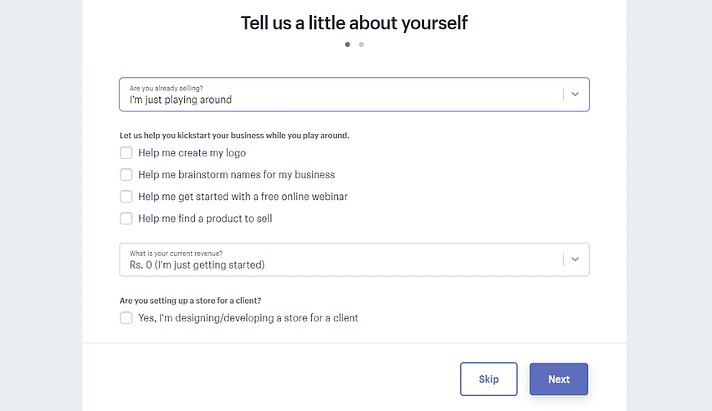
Store name and full address (including postal code) are required.
2. Go To The Shopify Admin Screen
When you’re ready, click Enter my store to go to your store’s Admin Screen after filling out the necessary information. You’ll have a lot of work to do in this Shopify part, which looks like this.
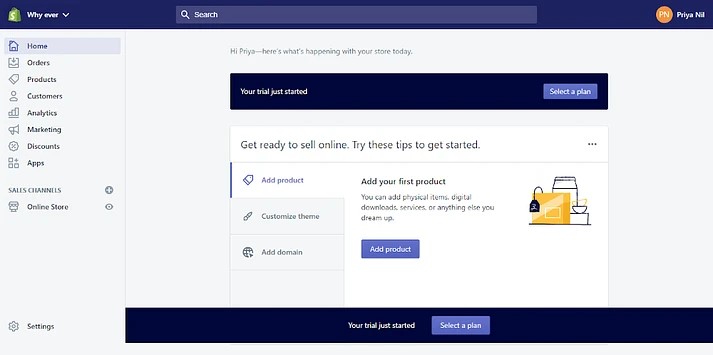
3. Choose And Customize Your Auto Parts Theme
Shopify themes set your store apart from the competition and make a statement with your customers.
You can switch out the current theme for another by visiting the Admin panel’s Themes page. Shopify also offers a good template for an E-commerce auto parts store.
Before settling on a single theme, you should carefully look at theme previews, demonstrations, and user reviews. Select “Free Theme” under the Online Store menu.
After selecting the Add button inside the theme’s interface, the theme will be added to your shop.
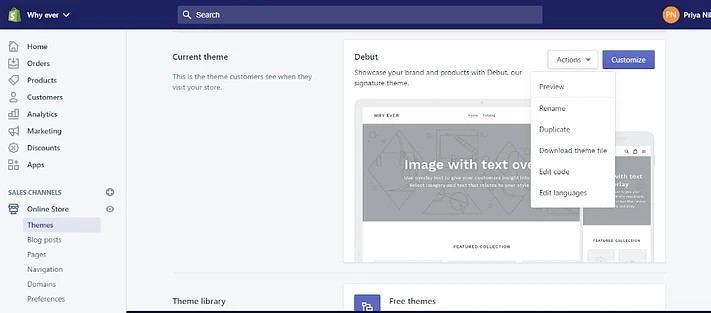
You can make seasonal variations of your published theme and use them for testing and previewing modifications. Many Shopify themes are available to you regardless of your plans. However, only one theme can be published at a time.
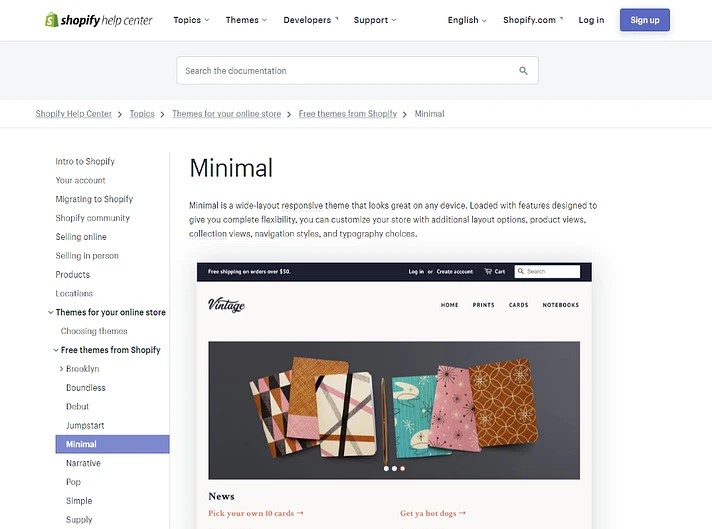
You’ll find all the tools you need to create an impression in these themes. You can rest assured that all available themes are fully compatible with Shopify. To fill in any gaps in your knowledge, third-party Shopify themes are available from various stores and marketplaces.
The way the theme presents your store is appreciable, but you can also make some adjustments to reflect your brand better. In that instance, you can alter the theme in various ways. To get to these settings, go to Appearance > Themes > Customize.

You’ll get access to the theme’s documentation, code, content, free stock photographs, image uploads, and more. Get assistance from “Shopify Experts” if you want to make significant modifications that need HTML or CSS but are uncomfortable with coding.
Top Shopify Auto Themes To Consider
Here is the following top 3 Shopify Auto Parts themes that you should consider.
1. Spare Parts Shopify Theme Development
It’s a simple, sophisticated and easy-to-use website for your car spare parts store.

2. Auto Parts Bootstrap Shopify Template
It’s one of the best themes that engage the audience with different animations. The banner and the front options can attract clients and help users to visit the top visiting pages.

3. Dream Auto Parts Shopify Theme
A responsive website that’s best for auto parts dealership Ecommerce site. The color theme is simple and light. Business owners can use the menu, banner and front category options to highlight to feature their desired products.
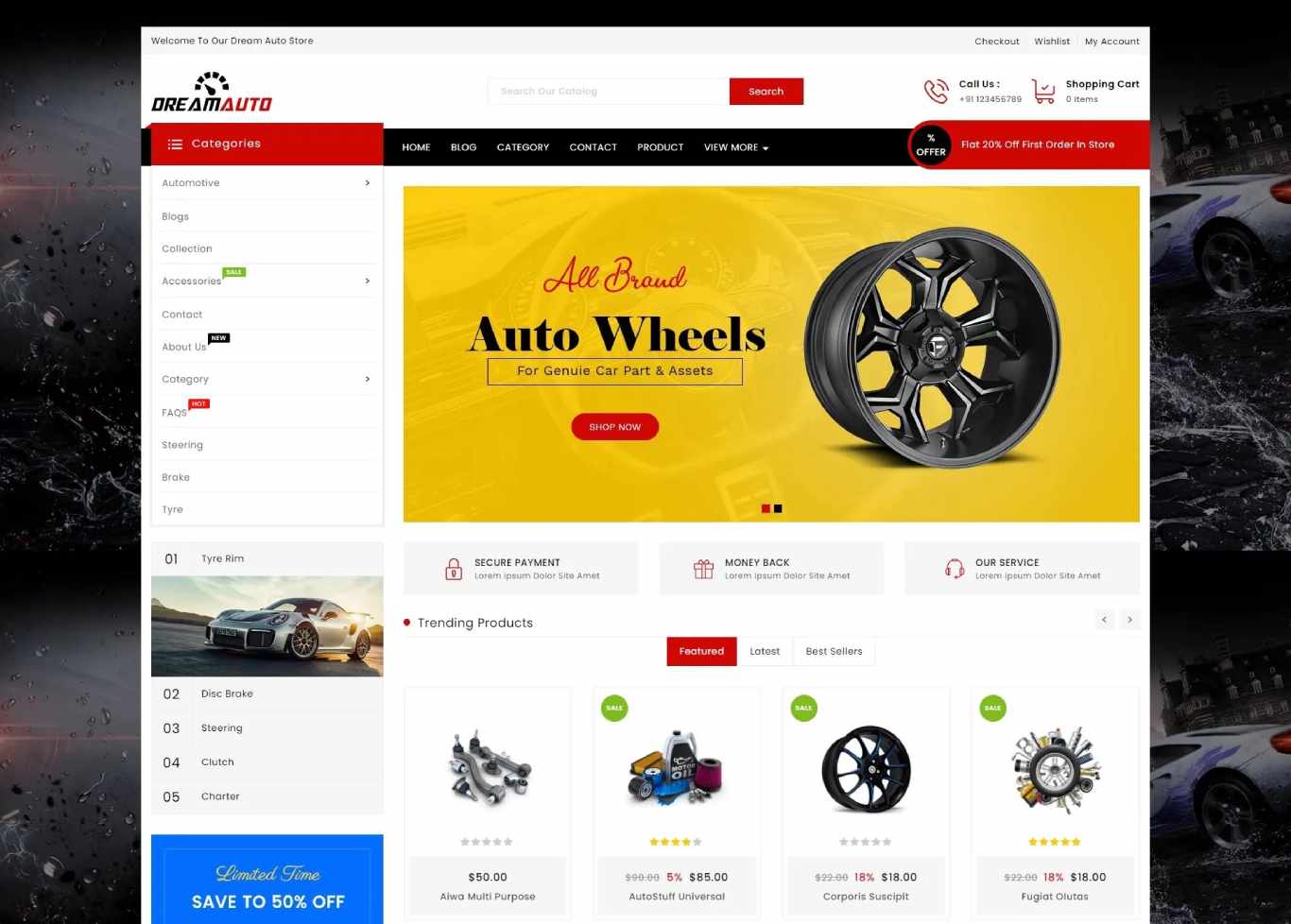
4. Add Auto Parts Products
Putting your auto parts for sale on your Shopify store is up next. To do this, select the Main menu -> Products -> All Products -> Add Products.
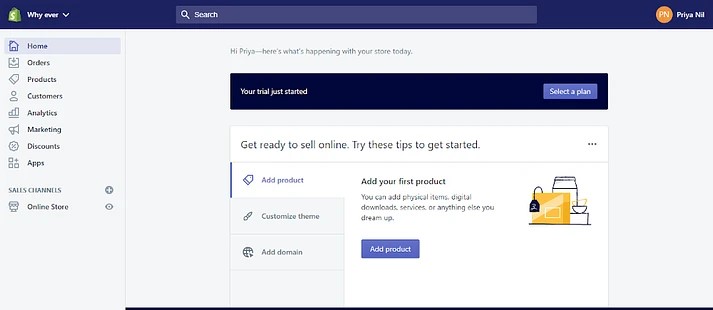
Here add everything you want to tell your consumers about the product they’re interested in. You can add pictures of the goods and a lot of information about it.
Including details that can help your readers locate the products using search engine optimization techniques is recommended. In the section labeled “Search Engine listing preview,” select “Edit website SEO,” and then add a meaningful title that will serve as a link in the search engine results. The URL can be changed, a keyword-rich description added, and redirects set up.
You can also make copies of product pages, combine them to make variants, and make additional changes to the product data under Products. The bulk editor permits the modification of multiple goods at once.
For each product, you’ll be able to specify where it will be sold in the “Product availability” area. Under the Management tab, you can assign product tags that will aid customers in locating specific items. A maximum of 250 tags (separated by commas) may be added for each product.
5. Add Minor Details
These additional settings are located in your store’s “Settings” section.
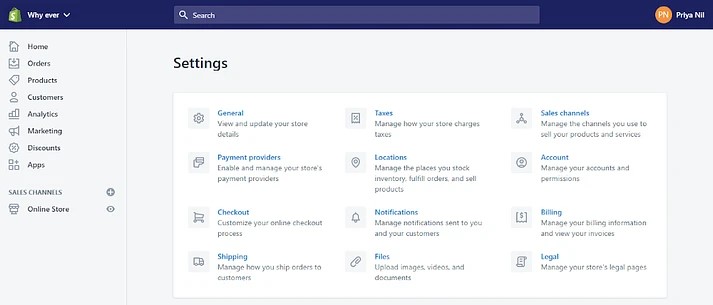
- A) General: you’ll be asked to provide basic information about your company.
- B) Location: Storefronts are helpful for stock control, order processing, and product sales.
Your shop’s locations can be anything that deals with stock, be it a storefront, a warehouse, a Shopify drop shipper, or even an inventory management app. The plan you select determines how many separate locations you can set up.
- C) Shipping: Before selling, you must determine which shipping options are most advantageous for your company.
Read Also How to sell on Shopify without Inventory
After that, you may provide your clients with the option to pay with these methods. The Shipping page of your Shopify Admin will display the shipping zone and rates applicable to the locations and countries you ship to.
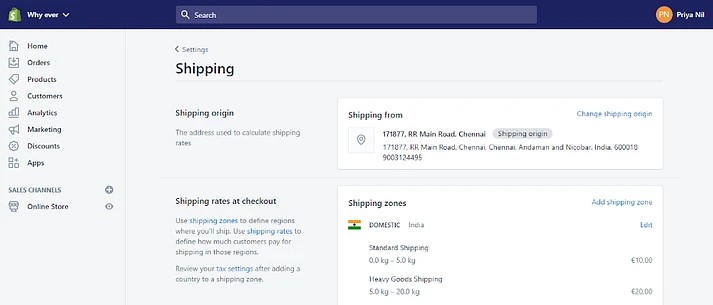
Shopify’s shipping options originate from warehouses in the United States and Canada. Because of this, you can now buy shipping labels that clearly show prices to customers and speed up shipping. The packages can be left at any post office.
It is essential to include the actual delivery expenses, as well as the weight and packaging of the product, when determining shipping rates. Shopify’s integration with the most common U.S. and Canadian shipping providers allows you to save over 50% off retail shipping rates when you buy labels in bulk.
Unexpected shipping costs are a common reason shoppers abandon their shopping carts during checkout. To combat this, you can provide free delivery on the customer’s order total and package weight or use a promotional code.
- D) Checkout – This is the page where customers place orders through Shopify’s safe checkout process. The theme settings allow you to alter the checkout page’s visual style and structure. Further, you can also edit Ecommerce shopping cart for auto parts to make the process easy for customers.
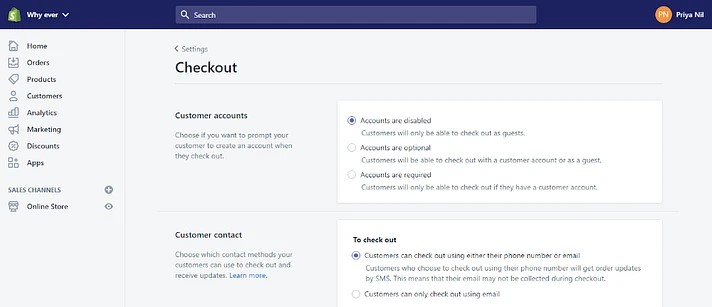
Here, you can ask consumers to sign up for an account with their username, password, and secure storage for details like their address, email, and purchase history. All of this information will be readily available at checkout.
E) Receiving Payments: Payment Processing in Shopify gives you many choices for accepting payments from your clients.
When deciding on a payment processor, it’s also essential to consider transaction fees, the cards accepted, and the availability of both online and offline checkout.
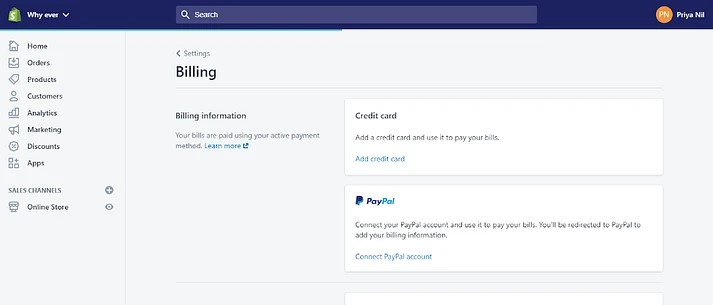
PayPal is the primary payment provider. However, other options like Amazon Pay and Apple Pay are also accepted. Some service providers also offer fast-track checkout buttons. It allows frequent customers to complete their purchases in a fraction of the time it takes first-time customers.
Set your store’s currency in Settings > General > Standards and formats > Change formatting.
- F) Taxes: You must collect taxes from customers and remit them to the government through legislation in most countries. Shopify simplifies this process by automatically calculating taxes in a variety of jurisdictions.
Shopify has predetermined prices, which you can either stick with or adjust. You may run many reports to assemble data to give to an accountant or use when filing tax returns.
6. Check out your Store
This step in the Shopify guide is where you should test your store before opening it to customers. That’s why you have the Fake gateway: to double-check that every aspect of your checkout process, inventory management, shipping, notification, and tax calculations is set up as you’d like it to be.
To disable a payment provider, go to Settings > Payment Provider. Select Add a provider > Third-party credit card provider > Provider > “Other > Bogus Gateway > Accept credit cards > Continue > Activate the gateway.
After that, place an order as if you were a regular customer to determine if everything is in order.
You may simulate a transaction using actual credit card numbers and verify if the funds were successfully transferred. However, to avoid paying transaction costs and get a refund.
7. Use Your Auto Parts Custom Store Domain
Once you’ve added your domain to Shopify, you’ll be ready to launch your online store. A Shopify domain name is necessary for users and search engines to locate your site. Shopify also has a premade answer for this problem.
Shopify provides a default domain, www.your-store-name.myshopify.com, to facilitate store creation. However, a more personalized URL like www.your-store-name.com will help customers remember your brand and improve your search engine rankings.

Shopify’s custom domains cost just $11 per year, and the platform takes care of the entire technical configuration for you. If you decide to leave the Shopify platform, you can maintain your domain name. In addition, while the domain plan does not include email forwarding, Shopify will forward unlimited messages to your specified email address.
That’s it. You’re done with your own auto parts Ecommerce platform.
In case you don’t want to do the above process yourself, you can always hire a Shopify website design services expert. They can do Shopify integration and Shopify Migration for your business.
FAQs
Is It Profitable To Sell Auto Parts On Shopify?
Considering the auto parts eCommerce growth rate, Shopify is an excellent starting point for an automotive components store. Shopify has numerous advantages, including built-in Product and order management options.
How Much Is The Profit Margin In The Auto Parts Business?
Business advisors in the auto industry typically recommend a 100 percent markup on all parts to achieve a 50-55% gross profit. The goal is to have a net operating profit of 30–35%, so a markup of this sort is essential. Failing businesses typically have net operational profitability of less than 15%.
What Causes The Majority Of Shopify Stores To Fail?
Aftermarket auto parts eCommerce development solutions suggest that the lack of a strategy significantly contributes to the demise of Shopify stores development. Keeping track of goals is a lot more challenging without a roadmap. In addition, there is a risk of making wrong decisions, which can create confusion.
Conclusion
Shopify is an excellent platform for launching your online store. It’s simple to implement and control and provides an extensive collection of built-in designs for use as starting points. There are a few factors to think about before opening an auto parts store.
Shopify auto parts eCommerce solution provides all the tools necessary to launch a business or grow an existing one in the digital sphere.
Shopify’s robust functions and helpful customer service let you concentrate on expanding your company rather than dealing with the nitty-gritty details of running an online store. Its recommended to hire a Shopify designer for Shopify custom development.
Source: https://ecommerce.folio3.com/blog/shopify-auto-parts-ecommerce-solution/






